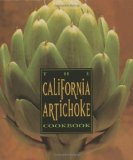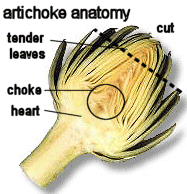The picture to the right illustrates how many artichokes our garden produced each week - I grow two of the most popular varieties and one that is difficult to find:
When shopping for artichokes you want to look for a tight, compact leaves and a fresh, green stem.
In the 16th century Catherine de Medici,married to King Henry II of France at the age of 14, and is credited with making artichokes famous there.
French immigrants brought artichokes to the United States in 1806 when they settled in the Louisiana Territory. Though the first commercial artichoke fields were developed in Louisiana they mysteriously disappeared by 1940. Meanwhile, artichokes were also established in California's Monterey area by the Spaniards. Today, almost all artichokes grown commercially in the United States are grown in California.
Medium and large artichokes have a hairy "choke" that needs to be removed - it is very unpleasant to chew and swallow. Cut these artichokes in half and scoop out the "choke" with a spoon or melon-baller. Baby artichokes do not have a choke so you do not need to preform this step.
When making cuts to artichokes either rub the cut portion with a lemon, or throw the pieces in acidulated water (water with lemon juice or vinegar) immediately to keep the cuts from turning brown or black.
Pasta Carciofata di Laura � Laura�s Artichoke Pasta
Tart yellow cherry tomatoes, baby artichokes and a little bit of fresh basil are the foundation of this dish. Together, with parmesan cheese, the ingredients create a delicate play of tart, bitter, sweet and salty flavors that harmonize together giving it that "hit the spot" taste.
1/2 lb of baby artichokes (or about 8)
1 basket of yellow cherry tomatoes
16 oz box of spaghetti
Grated Parmigiano Reggiano Cheese
olive oil
salt
pepper
fresh basil to garnish
Clean the baby artichokes by soaking them in cold water. Put you skillet on low heat with a little olive oil. Pat dry the baby artichokes, snap off the first layer or two of external leaves and cut off the top 1/3. Then, slice them in halves or thirds (depending on their size) in either wedges or crooss-sections (these are beautiful but difficult to do). As you're cutting the artichokes toss them immediately the skillet. When you've finished cutting, shake the skillet a bit or turn the baby artichoke slices to an evenly golden coat- they may be ready at different times. Take each piece out of the pan as they're done and put aside. Leave the skillet on a low flame.
Now, clean and cut the yellow cherry tomatoes in half and toss them all in the skillet - add olive oil if necessary. You should hear a sizzle.
You can now turn on your pasta water.
Stir the cherry tomatoes occasionally. When the cherry tomatoes are just beginning to get little brown edges, add the cooked artichokes you have put aside to the skillet. Grind pepper and sprinkle a bit of salt to taste.
Put your dry spaghetti in the water, stir occasionally. Cut the basil into strips by rolling several leaves together and then slicing- put aside. When the pasta is done, usually about 7 minutes, drain in a colander and then bring the spaghetti to the skillet. Stir for about a minute and then turn off the flame. Serve in individual bowls with a sprinkle of basil on top.
Let your guests grate parmesan cheese to taste.
Chef's Note: If your cherry tomatoes are sweet and not tart, squeeze a little lemon juice in the skillet right after you have added the pasta.
eating whole artichokes
It is both proper and polite to pluck the leaves with your fingers, leaving fork and knife aside. Pull off a leaf, holding it by the pointed end. Put the other end in your mouth and pull it between your teeth, scraping the length of the leaf (the edible portion of the leaves becomes greater as you get closer to the center of the artichoke).
If you're provided with a dip, put a small part of the edible portion of the leaf in the dip and scrape with your teeth. Don't overdo it on the dip or you won't taste the artichoke.
When the leaves are pulled, you will be left with the base, the heart, crowned with a fuzzy patch (the choke). You have now reached the artichoke heart. Carefully scoop away the choke with your knife or spoon. With knife and fork, cut bites from the heart.
|
Carciofi Interi - Whole Artichokes
Whole, cooked artichokes can either be eaten by themselves or served with a sauce for dipping. When serving, be sure to have an empty bowl to put the remainder of the eaten leaves.
4 tablespoons light mayonnaise
2 teaspoon dijon mustard
4 large artichokes
1 tablespoon lemon juice
dash of paprika
In a small bowl, combine mayonnaise and mustard. Sprinkle a little paprika on top. Cover and refrigerate until ready to serve.
Wash artichokes under cold, running water. Pull off lower petals and cut off the stem (cut flush with the base so it can stand upright). If the leaves have thorns on the ends, cut off about 1/2 inch of the top of the artichoke. Trim tips of the reamining leaves with scissors. Dip in lemon juice to preserve color.
In a large pot add approximately 2 cups of water and the remaining lemon juice; bring to a boil.
Place the prepared artichokes in the boiling water, cover with lid, reduce heat to simmer, and let cook for approximately 20 to 40 minutes (depending on size). The artichokes are done when the leaves pull away easily. Remove artichokes from the boiling water with tongs and drain them upside down in a colander. Bring to room temperature before serving.
Serve warm or cool with the dip.
Makes 4 servings.
Carciofi Ripieni - Stuffed Artichokes
1 cup of bread crumbs
6 medium artichokes, cleaned and choke removed
1 the juice of one lemon
1 pound lean ground pork
3 eggs
2 cloves of garlic
Salt and pepper
1/2 cup unbleached flour
extra virgin olive oil
16 oz can of whole tomatoes
1 onion
1 bunch Italian parsley
Soak the bread crumbs in 1/2 cup of water and set aside.
Trim each artichoke, cut in half, scoop out the fuzzy (choke) and put in a water bath with the lemon juice.
In a mixing bowl combine the pork, damp bread crumbs, 1 egg, 1 chopped clove garlic, 1 teaspoon salt and a pinch of freshly ground black pepper and mix well to combine. Form the mixture into oval-shaped meat balls.
Remove the artichoke pieces from the lemon water and pat dry with a paper towel. Place 1 meatball between 2 pieces of artichoke, pressing to hold together. Roll each "sandwich" in flour, patting off the excess, and lay each on a sheet tray.
In a separate bowl, beat the remaining 2 eggs and add a pinch of salt.
In a large, heavy-bottomed pot, heat 1 cup olive oil over high heat until just smoking. Dip the artichokes in the egg mixture, let the excess drip off, and cook in the hot oil until they are golden brown on all sides. Work in batches if necessary, to avoid lowering the temperature of the oil. Remove the artichokes from the oil with a spider or slotted spoon and drain on paper towels.
In a skillet large enough to hold the artichokes in a single layer, sweat (don't brown) the chopped onion. Then, arrange the artichokes and add the tomatoes and their juices, the remaining 1/4 cup olive oil, the remaining chopped clove of garlic, parsley and salt and pepper, to taste. Simmer over medium heat, lowering if necessary to avoid scorching, for 20 to 30 minutes, until the liquids are of a fairly thick consistency.
Serve immediately.
Carciofi alla Giudea - Artichokes Jewish Style (Fried)
6 round young artichokes, trimmed, stalks peeled
1 liter extra-virgin olive oil
Salt and pepper, to taste
Hold the artichokes in acidulated water after trimming, to keep from discoloring.
In a heavy-bottomed, tall-sided pot, heat the oil to 300 degrees F.
Meanwhile, drain the artichokes and press them "face" down against a hard surface so that they open like flowers. Season the inside of each choke with salt and pepper. Fry each choke in the hot oil, working in batches, keeping them submerged with a slotted spoon or spider. After 10 minutes, increase the heat to 350 degrees to finish cooking. Remove from the oil, drain on paper towels and, if necessary, season with salt and pepper again.
Source: Mario Batali's Molto Mario
Carciofi alla Romana - Roman Style Artichokes
1 tablespoon chopped fresh parsley
3 tablespoons chopped fresh mint
2 cloves garlic, finely chopped
Salt, to taste
1 tablespoon plus 3/4 cup extra-virgin olive oil
6 artichokes, halved and trimmed of coarse (but not inner) leaves, choke removed, held in acidulated water
1/2 cup dry white wine
3/4 cup boiling water
In a small bowl, combine the parsley, mint, garlic, salt and 1 tablespoon olive oil. In the cavity of the artichoke from which the choke was removed, place 1 teaspoon of the herb mixture. Repeat this procedure with the remaining chokes. Arrange all chokes in a deep pan that keeps them close together, in other words, one that doesn't give them room to fall over. Add the wine, boiling water, remaining oil and a pinch of salt. Cover and simmer on the stovetop 1 hour.
Serve hot or at room temperature.
Source: Mario Batali's Molto Mario




 Artichokes have been used in art, sculpture and, most importantly, cooking for millennia. Many people are intimidated by this beautiful vegetable because they don�t know where to begin to clean, cook and eat it.
Artichokes have been used in art, sculpture and, most importantly, cooking for millennia. Many people are intimidated by this beautiful vegetable because they don�t know where to begin to clean, cook and eat it.


 For both sizes, you'll want to snap off the outer leaves until you get to the lighter, tender leaves. Also, you'll want to cut off the top 1/3 of the leaves (see dotted line in illustration).
For both sizes, you'll want to snap off the outer leaves until you get to the lighter, tender leaves. Also, you'll want to cut off the top 1/3 of the leaves (see dotted line in illustration).